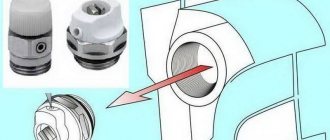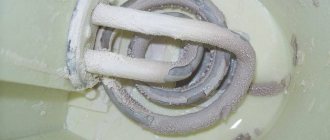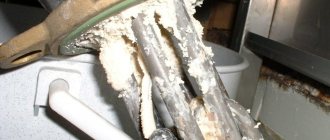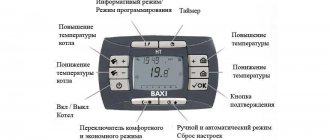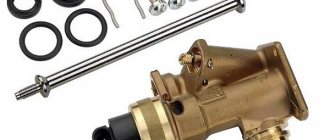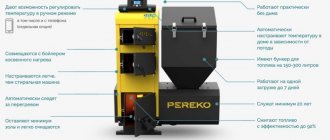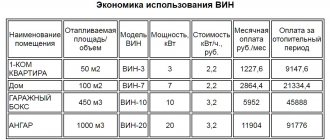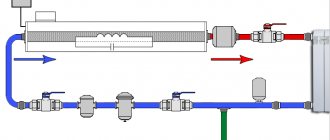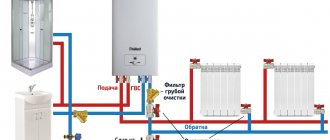Why do you need regular gas boiler cleaning?
For most of the year, water constantly circulates in the heating system. Over time, a coating of salts, lime, and impurities that enter the coolant settles on equipment parts. The harder the water, the more mineral deposits appear on the system elements. They remain in the heat exchanger for the gas boiler, which negatively affects its operation.
Heating equipment in the house
The operating principle of heating equipment is based on the fact that the coolant is heated as it passes through the curved channels of the coil. To raise the temperature of the liquid, special plates are used. Thanks to these additional elements, the coil itself and the water entering it are heated more evenly. When assembled, the system looks similar to a car radiator.
The operating efficiency of equipment largely depends on the thermal conductivity of the materials from which it is assembled. Usually copper or alloys with this metal are used. Any growths or deposits on the internal surfaces of the coil tubes lead to a decrease in thermal conductivity and deterioration of the system.
Deposits in the heat exchanger for the boiler
Preventive measures are beneficial
If equipment is not cleaned promptly, problems may arise:
- The heat exchanger of a gas boiler constantly overheats and fails faster. It can be replaced, but such repairs are very expensive. To this amount should also be added the inconvenience and cost of heating the house during the period when the equipment is being repaired. Electric heaters are usually turned on, and this significantly increases the cost of repairs.
- Limescale greatly impedes the passage of coolant through the system. The more scale there is, the higher the load on the circulation pump. The equipment has to constantly work in emergency mode, which leads to natural wear of spare parts and negatively affects its service life.
- A clogged boiler heat exchanger works less efficiently. It takes more energy to heat it. Accordingly, gas consumption increases (on average by 10-15%). This means that the owner will overpay for heating, and the house will not warm up as well. Simple calculations show that for the season the amount will be close to that paid on bills for a whole month.
Do-it-yourself device for washing heat exchangers
Cleaning methods: how to clean a gas boiler
To prevent overheating of equipment parts, breakdowns and increased fuel costs, periodic flushing and cleaning of the heat exchanger and other elements is required.
Cleaning the heat exchanger can be done in several ways:
- Manual cleaning, which involves removing the coil, can be done mechanically, or you will have to rinse the pipe with a special composition that dissolves salt;
- Cleaning with acidic liquid using a booster;
- A hydrodynamic flushing option using increased pressure is possible.
Manual cleaning is carried out using a stiff brush and vacuum cleaner. For a double-circuit boiler, you should use anti-salt liquid against limescale. First, the coil is removed, and after the procedure it is returned to its place
Particular attention must be paid to checking the tightness
The hydrodynamic method allows you to effectively destroy plaque and deposits by increasing pressure and using abrasive substances pumped into the coil.
How often do you clean the heat exchanger in a gas boiler?
The frequency of cleaning the heat exchanger depends primarily on the type of coolant and the design features of the unit itself. It is least common to service single-circuit boilers in heating systems that use purified water as a coolant. To keep them in good condition, it is enough to carry out preventive maintenance once every 4 years.
If untreated water circulates in the system, the boiler should be flushed once every 2-3 years. If the water is hard, then the cleaning regime is once every 2 years. The secondary heat exchanger of a double-circuit boiler must be washed with the same frequency, because unfiltered tap water with impurities flows through it.
Most often, maintenance is required for equipment in heating systems where antifreeze is used as a coolant. It should be washed at least once every 2 years. In addition, you have to monitor the expiration date of antifreeze and replace it in a timely manner. Otherwise, the efficiency of the system will decrease and heating costs will increase.
When cleaning heat exchangers, pay attention to the appearance of the boilers and nozzles and, if necessary, carry out repair work. You should also monitor the condition of chimneys and clean them of soot in a timely manner. These simple measures extend the life of heating equipment and prevent breakdowns.
Antifreeze for heating systems
Why does a gas boiler become clogged with soot?
- Incorrect ratio of gas and air proportions during combustion.
- Poor quality fuel.
The formation of soot due to incomplete combustion of gas can be easily prevented if a specialist is invited to install and adjust the boiler. Every year, during seasonal maintenance, the operating parameters of the burner and the composition of the CO emitted are checked.
How to clean nozzles on a gas boiler
- Mechanical method - this is how gas workers clean injectors during regular seasonal maintenance. The ash is removed with a special tool that resembles a curved hook.
- Using chemicals – heavy stains are removed with reagents. For cleaning, the burner device will need to be removed.
- The ultrasonic method is a relatively new cleaning method that allows you to get rid of carbon deposits with minimal consequences for the burner and the nozzles themselves. It is carried out on specialized equipment.
Which gas boiler heat exchanger is less susceptible to scale?
- Cast iron heat exchangers have the best resistance to the appearance of salt and mineral deposits. The service life of boilers is about 35 years. The circuit is made of cast iron, resistant to any aggressive substances.
- The heat exchanger is made of stainless steel and is resistant to corrosion, but after several years of operation, deposits of metal salts begin to appear on the walls of the circuit cavity.
- For copper heat exchangers, the first place in terms of the intensity of deposits is prepared. The process of scale formation is accelerated if aluminum fittings, adapters or radiators are used in the heating or hot water system.
Cost of flushing and cleaning a gas boiler
- Chemical washing – 300-600 rub.
- Washing equipment (booster), starting from 15 thousand rubles.
- Brushes and sponges for cleaning – 50-100 rubles.
- Once every 2 years, in urban conditions.
- Every year, when installed in rural areas.
Contact a professional or do it yourself
Professional cleaning of heating boilers is an expensive proposition. Depending on the condition of the equipment and the specifics of its operation, amounts can range from several tens to hundreds of dollars. In addition, the masters rarely arrive within the next few hours; sometimes you have to wait for them for several days. It is not comfortable.
The cost of professional cleaning using a special station for washing heat exchangers pays off: the parts are washed from the inside to a shine, and the equipment works much better. But if you want, you can always save money and do the same thing yourself. The result will be no worse, and you will only have to invest your own time and effort.
Professional device for washing heat exchangers
Why is scale dangerous?
Everyone has seen a teapot covered in sediment inside. This type of deposit occurs as a result of the action of high temperature on the salts in the water. They, like other heavy substances, precipitate.
Gradually the layer of scale increases. The same process occurs in heating boilers.
As a result, the boiler:
- loses efficiency;
- fuel consumption (gas, pellets, firewood, coal) increases sharply;
- electricity consumption increases (starting the boiler using pumps);
- may fail prematurely if the heat exchanger burns out.
To stop all irreversible processes and return heat to the house, you need to use a special descaling agent for heating boilers.
How to determine the appearance of scale in boilers
Possible boiler contamination is indicated by:
- noise and pump breakdown;
- the appearance of extraneous sounds in the heating system and in the boiler;
- different temperatures in radiators of the same size;
- increased consumption of gas or other fuel.
Methods for cleaning the heat exchanger of a gas boiler
There are two main types of flushing the heat exchanger of a gas boiler - with and without disassembling the unit. To disassemble the equipment, you will need tools. Which ones specifically - it depends on the design of the heating equipment. In some cases, it is impossible to remove the heat exchanger at all, but you can gain access to it by removing some of the parts.
Dismantling the heating boiler
Before starting work, you should prepare the equipment:
- Disconnect the boiler from all power sources, drain the water from the system and expansion tank. To drain the coolant, special fittings must be provided. If this is not the case, then you will have to turn off the water supply to the house, and then drain it from the system into pre-prepared basins and buckets.
- When there is no water left in the system, you can begin to disassemble the equipment. First, remove the front of the housing to gain access to the heaters. If the boiler is double-circuit, then the second circuit heater is located closer, the main one is further away. To remove it, you need to disassemble the combustion chamber.
- Construction parts are usually dirty. It is advisable to wash them outside with special compounds that remove soot and carbon deposits. If there are no such products, you can take traditional household chemicals that are used for cleaning stoves - gels, cleaning pastes, etc. They should be used only in extreme cases, since even the most aggressive household chemicals cannot remove carbon deposits as efficiently as specialized ones, but they can damage materials.
- The inside of the unit elements can be washed with a strong aqueous solution of citric acid. It does not corrode metal, but removes plaque and lime deposits well. Most often there is a lot of scale. It is impossible to cope with it by half measures. In this case, you will need equipment for washing the heat exchangers of gas boilers. You can make a simple installation with a circulation pump with your own hands.
Soot and carbon deposits on heater parts
There are three main ways to clean boilers: manual, hydrodynamic, and chemical washing of boilers. Let's look at them in more detail below.
Flushing the heat exchanger
Option #1: DIY manual cleaning
Manual cleaning is called cleaning of boilers without the use of special mechanisms. You will only need simple tools that are found in almost any home. The boiler must be partially disassembled to gain access to the heat exchanger and remove it. Next, you should decide how best to remove the dirt - mechanically or using chemical solutions.
If you decide to remove plaque mechanically, you should stock up on a scraper, brush and vacuum cleaner to remove small particles of deposits. If you plan to chemically descale boilers, you can use a citric acid solution, or even better, buy a specialized product.
The MasterBoiler and SVOD TVN Professional brands have proven themselves well. They come in different forms. There are liquids that do not require special preparation before use, and powders. When using, you should carefully read the instructions. Some formulations foam, and you need to be prepared for this.
How to clean a gas boiler from scale? Almost all compositions are suitable for removing calcium carbonate deposits, while only certain preparations cope with iron oxide deposits. When purchasing a product, it is important to make sure that it is intended specifically for those types of deposits that are typical for a particular boiler. Among the popular preparations that remove iron oxide plaque, we recommend SVOD TVN Extra.
SVOD TVN Professional
Advice. When disassembling and cleaning the boiler, try to be extremely careful so as not to damage the parts. When installing them in place after manipulation, check the tightness of each connection.
Clean heat exchanger
Option #2: chemical washing
Boosters are often used to flush boilers. These are special installations that pump liquid into the heat exchanger channels. You can make a booster for washing heat exchangers with your own hands by connecting a circulation pump so that it drives the acid solution, washing the equipment from the inside.
A good flush may take up to 10 hours if the channels are very dirty, but usually it takes much less time. Cleanliness indicators: carbonate and iron deposits completely disappear, and the internal surfaces of the channels shine. To neutralize the residues of acidic preparations, special compounds are used; they are poured into a booster to wash the heat exchangers at the end of the procedure.
Chemical wash booster
Option #3: hydrodynamic cleaning
Hydrodynamic flushing of boilers and heat exchangers is similar to chemical flushing, since it also uses pumps and acid solutions. The main difference is that the liquid is pumped under high pressure. Sometimes preparations with abrasives are used as cleaning agents.
Since deposits are destroyed by water hammer, the procedure itself is quite dangerous. If the pressure is higher than permissible, the pipes may be damaged, and their repair will cost a significant amount. It’s better not to take risks and entrust this work to professionals.
Condition of the heat exchanger before and after cleaning
Methods for cleaning boilers from scale
Experts call removing scale from a boiler by flushing.
Two methods have been developed for cleaning a heating boiler:
- collapsible;
- in-place.
If you decide to use the dismountable method of cleaning the boiler from scale with your own hands, you will have to gradually remove all components of the boiler that have been subjected to scale formation. The dismantled parts must be placed in a prepared container with a chemical reagent and left there for several hours. After the time has passed, the components are removed, thoroughly rinsed with clean water, dried and placed in their original places.
In the case of the disassembly-in-place method, the heating boiler is not disassembled into components, and it is washed to remove scale and sediment directly at the installation site. In this case, to remove scale you will need a special device called a booster.
The structure of the booster assumes the presence of the following components:
- tank with a chemical reagent;
- circulation pump;
- an electrical device for heating liquid.
The method of removing scale from a boiler using a booster includes a number of sequential actions:
- The gas boiler is disconnected from the gas pipeline, and the solid fuel boiler is stopped heating and allowed to cool well.
- Water is drained from the boiler heat exchanger.
- The boiler is disconnected from the general heating system.
- Then the booster is connected.
- Over the next 5-6 hours, the device pumps a chemical reagent through the boiler heat exchanger.
- Then all waste liquid is drained.
- After thorough washing, the boiler is reconnected to the general heating system.
Please note that in order to more effectively remove scale and salt deposits from the boiler, it is necessary to rinse it with a booster several times in a row.
Do-it-yourself cleaning from soot and soot
Soot and soot make it difficult for heating equipment to operate. There are models that automatically turn off in such cases. If this does not happen, then combustion products may enter the room. Harmful gases can poison the residents of the house, so it is important to clean boilers on time to prevent such situations.
Heat exchanger cleaning agent
Work order:
- Prepare the tools: brushes, screwdrivers, open-end wrenches (most often wrenches size 8-17 are suitable), needle, brush, rags. If you plan to completely clean the channels at the same time, you will also need a means for flushing the gas boiler heat exchanger.
- Turn off the gas, remove the front wall of the boiler, disconnect the wires, ignition electrode, burner tube. During cleaning, it is advisable to immediately replace the pilot burner gasket
- Next, you should get the burner and swirlers. They and the surface of the heat exchanger are cleaned with brushes - soft and for metal. The inside of the channels is blown out using a vacuum cleaner.
- It is convenient to clean the burner with a brush and a needle smaller than the diameter of the burner hole.
Boiler design diagram
Advice. Do not try to widen the burner hole with a thicker needle. It will be easier to clean next time, but the performance of the heating equipment may deteriorate.
DIY booster
- When cleaning and washing the heat exchangers of gas boilers with your own hands is completed, the equipment is reassembled in the reverse order. First, install the burner, nozzle, tube, connect the ignition electrode, etc.
- The assembled boiler is tested. It is turned on and the connections of the tubes and burners are checked for tightness. If the equipment operates normally, it can be put into operation. If there are any malfunctions, the boiler will need to be disassembled again and the connections sealed.
Replacing the heat exchanger in a gas boiler with your own hands
How to clean a heat exchanger
The heat exchanger is cleaned at the end of the heating season. To carry out the work, it is enough to have a standard set of tools. Before starting work, it is necessary to disconnect the boiler unit from the gas network (main or local) and electricity.
Let's look at how to clean a floor-standing gas boiler
:
- first of all, the burner device is dismantled;
- it is necessary to disconnect all wires from the gas valve;
- a thermocouple is removed from the combustion chamber and connected to the gas valve by a capillary tube;
- the fuel supply pipe is disconnected;
- the bolts or nuts (4 pcs) securing the stove with the burner are unscrewed, the assembly is removed out.
It is convenient to clean the gas boiler burner with an old toothbrush. Soot must also be removed from the flame control sensor, igniter, and piezoelectric device for automatic ignition.
To get to the boiler heat exchanger, remove the top cover of the unit, disconnect the draft sensor and chimney, remove the insulation, dismantle the casing fasteners and the casing itself. Having gained access to the heat exchanger, it is necessary to remove the turbulators from it.
A soft metal brush is suitable for cleaning turbulators, and the heat exchanger itself is freed from soot deposits with a miniature scraper made of thin metal. A brush with a long handle is also used. First of all, the smoke pipes are cleaned and swept, then the soot that has fallen off on the bottom should be removed.
Cleaning the wall-mounted boiler is done with a toothbrush.
Cleaning a wall-mounted heat generator. After turning off the gas supply, it is necessary to dismantle the front panel of the boiler. Then the front cover is unscrewed, which closes the combustion chamber. It is recommended to cover the nozzles with a sheet of thick paper to prevent the burner from becoming clogged by falling soot. Do-it-yourself cleaning of the heat exchanger of a double-circuit boiler is done using an old toothbrush or a brush with metal bristles. After cleaning is completed, you need to sweep the heat exchanger with a brush and carefully remove the paper with the collected soot. See the video below to see how the procedure is performed.
Flushing a single-circuit and double-circuit gas boiler
Flushing the heat exchanger of a gas boiler is necessary to remove internal deposits that can disrupt the normal circulation of the coolant in the heating system and cause problems with the supply of hot water to the local hot water system. Also, deposits may contain substances that destroy metal.
How often this activity needs to be performed depends on the type of coolant. If purified water circulates in the system, it is enough to carry out preventive maintenance once every four years, removing deposits. A system with antifreeze should be flushed every two years and the coolant should be changed regularly - under the influence of high temperatures, it changes properties over time and can become dangerous for the metal elements of the system.
